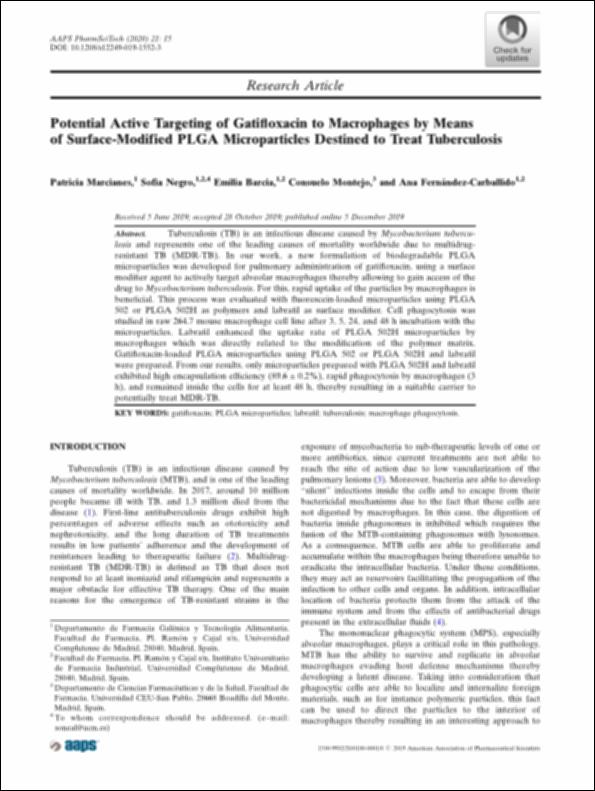Please use this identifier to cite or link to this item:
http://hdl.handle.net/10637/14800Potential Active Targeting of Gatifloxacin to Macrophages by Means of Surface-Modified PLGA Microparticles Destined to Treat Tuberculosis
| Title: | Potential Active Targeting of Gatifloxacin to Macrophages by Means of Surface-Modified PLGA Microparticles Destined to Treat Tuberculosis |
| Authors : | Marcianes, Patricia Negro, Sofía Barcia, Emilia Montejo Rubio, María Consuelo Fernández Carballido, Ana |
| Keywords: | Gatifloxacin; PLGA microparticles; Labrafil; Tuberculosis; Macrophage phagocytosis |
| Publisher: | Springer |
| Citation: | Marcianes, P., Negro, S., Barcia, E. et al. Potential Active Targeting of Gatifloxacin to Macrophages by Means of Surface-Modified PLGA Microparticles Destined to Treat Tuberculosis. AAPS PharmSciTech 21, 15 (2020). https://doi.org/10.1208/s12249-019-1552-3 |
| Abstract: | Tuberculosis (TB) is an infectious disease caused by Mycobacterium tuberculosis and represents one of the leading causes of mortality worldwide due to multidrugresistant TB (MDR-TB). In our work, a new formulation of biodegradable PLGA microparticles was developed for pulmonary administration of gatifloxacin, using a surface modifier agent to actively target alveolar macrophages thereby allowing to gain access of the drug to Mycobacterium tuberculosis. For this, rapid uptake of the particles by macrophages is beneficial. This process was evaluated with fluorescein-loaded microparticles using PLGA 502 or PLGA 502H as polymers and labrafil as surface modifier. Cell phagocytosis was studied in raw 264.7 mouse macrophage cell line after 3, 5, 24, and 48 h incubation with the microparticles. Labrafil enhanced the uptake rate of PLGA 502H microparticles by macrophages which was directly related to the modification of the polymer matrix. Gatifloxacin-loaded PLGA microparticles using PLGA 502 or PLGA 502H and labrafil were prepared. From our results, only microparticles prepared with PLGA 502H and labrafil exhibited high encapsulation efficiency (89.6 ± 0.2%), rapid phagocytosis by macrophages (3 h), and remained inside the cells for at least 48 h, thereby resulting in a suitable carrier to potentially treat MDR-TB. |
| URI: | http://hdl.handle.net/10637/14800 |
| Rights : | http://creativecommons.org/licenses/by/4.0/deed.es OpenAccess |
| ISSN: | 1530-9932 |
| Issue Date: | 5-Dec-2019 |
| Center : | Universidad San Pablo-CEU |
| Appears in Collections: | Facultad de Farmacia |
Items in DSpace are protected by copyright, with all rights reserved, unless otherwise indicated.


